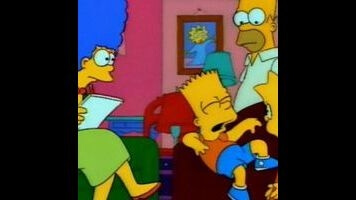When “Treehouse of Horror II” came out in 1991, audiences couldn’t hit a K-Mart without being inundated with shelf upon shelf of Simpsons merchandise, each piece of poorly-constructed ephemera more shameless than the last. The Simpsons has never been shy about making post-modern digs at itself, but it has seldom done so as trenchantly or insightfully as it does when, in the episode's parody of The Monkey's Paw, one of the Simpsons wishes for the clan to be rich and famous, and sure enough, the family’s fame and fortune within the show matches its fame and fortune in the real world.
It’s through the looking glass time, as the inhabitants of Springfield respond to the family’s fame the same way much of the rest of the world did: amusement veering into irritation and then something much darker and less generous. The Simpsons had gotten bigger than anyone had imagined. That must have filled the cast and crew with a profound sense of ambivalence that informs the first tale of the macabre in “Treehouse of Horror II.”
The writers didn’t have to exercise their imaginations too much to dream up ways that the Simpsons could be merchandised that would fill even Krusty with shame. It’s considerably less than a hop, skip, and a jump from the real-life quickie cash-in album The Simpsons Sing the Blues to the faux-quickie-cash-in-album The Simpsons Sing Calypso, and I’m half-surprised Bart didn’t do an ad encouraging women to have a mammogram, man.
A show like Family Guy might devote an entire episode to spoofing its characters' insufferable cultural ubiquity, but “Treehouse of Horror II” has so much on its mind that it treats the family’s regrettable desire to be rich and famous as little more than a throwaway gag, a quick, winking nod that, yes, we’re just as sick of the Simpsons' smiling yellow mugs showing up everything from toothpaste to yellow mugs as you are.
In the last entry, I wrote a lot about the show’s inspired use of misdirection. For example, in this episode, when Marge asks Homer where he bought the Monkey’s Paw, he points to a mysteriously disappearing cloud of smoke. Our highly suggestible minds are trained to associate mysteriously disappearing clouds of smoke with supernatural motherfuckery, but just when it seems the joke is traveling down one direction it steers course to reveal that the mysteriously disappearing cloud of smoke has nothing to do with story at hand. It’s there as half-red herring, half non-sequitur. It’s a gag that works in part because it respects audiences enough to assume they’re familiar with the clichés and conventions it's spoofing. But it goes beyond that. The joke isn’t that the Simpsons are living out Monkey’s Paw; that’s merely the framework.
There is a twist beyond the twist, however. After Homer’s misadventures with the Monkey’s Paw, he hands off his gift/curse to stupid sexy Flanders with the understanding that it would bring his nemesis just as much distress and overly dry turkey sandwiches as it had brought him. Flanders is pure of heart, however, and his wishes lead to nothing but sunshine and lollipops.
In 1991, Bart Simpson towered over the sum of pop culture like a colossus. He came; he saw; he conquered. It seemed as if the very world bowed at his feet, as it does in the episode's second segment, a candy-colored riff on “It’s a Good Life,” a classic Twilight Zone episode about a town ruled by the juvenile whims of a demonic 10-year-old boy with psychic powers and the ability to read minds.
“It’s a Good Life,” in all its various incarnations (it was also adapted by Joe Dante for a killer segment in the Twilight Zone movie), somewhat subversively suggests that the fundamental nature of childhood is cruel and bored, not innocent and sweet. Accordingly, a world ruled by a 10-year-old boy’s sugar-addled whims is a nightmare realm where exhausted and dispirited adults humiliate and debase themselves for Bart’s amusements and everyone lives in mortal fear of dying or suffering a worse fate, should they let their façade of painfully strained fake happiness lapse for even a moment.
The segment is almost too dark to be funny, at least in the funny ha-ha sense. Bart’s hero worship of Krusty, for example, takes on an ominous dimension as he forces his hero to work past the point of exhaustion for his own private amusement. If given a choice, Bart will consume and consume and consume until there’s nothing left.
Anthologies are seldom rock-solid from start to finish. “Treehouse of Horror II” is no exception. After two smart, funny, and savagely satirical segments, the third offers a weak variation on the Frankenstein mythology, with Mr. Burns as Dr. Frankenstein and Homer as a sort of robo-Frankenstein’s Monster. As with the previous year’s “The Raven” segment, a dull sense of obligation hangs heavy over the episode: It’s as if the writers are dusting off that creaky old tale because they have to, not necessarily because they have a fresh angle or anything new to add to the topic. The segment’s weaknesses are even more egregious, considering the episode covered similar thematic territory much better in a much later episode featuring Jerry Lewis as Professor Frink’s father. Otherwise, however, this was a characteristically strong exploration of our fears, anxieties, and obsessions, circa that giddy lost age of 1991.









































